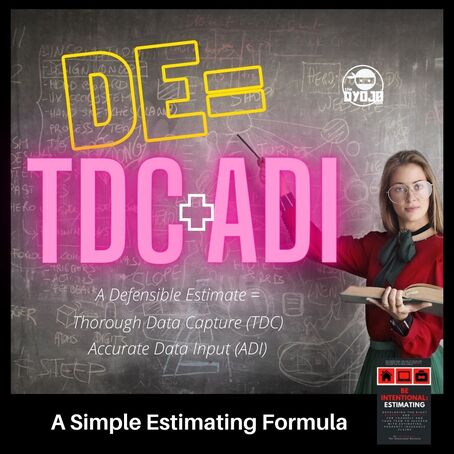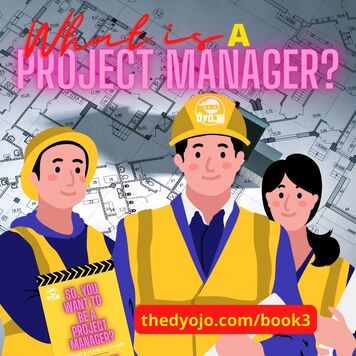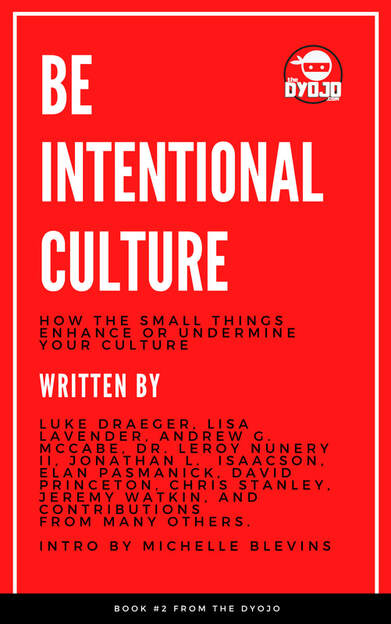|
We put the question back to you in the DYOJO Podcast audience - where have some of your best hires come from? Some people hire from the franchise system thinking, "Well, if I'm in this franchise system, and they're in this franchise system, they could plug and play." Has this worked for you? A lot of contractors try to hire someone who has worked for a competitor. Expecting that they have some experience that will set everyone on the right foot. What have your results been with re-hires? I've shared many times before that my personal preference is I'd rather train new habits than retrain old habits. In this episode, I share some examples of doing this at multiple levels in a construction organization. From the technician level, superintendent, project manager, and even at the estimator level. This is what has worked best for my teams. Hear more about this process of recruiting, hiring, developing, and retaining quality young professionals in The DYOJO Podcast Episode 112. The DYOJO Podcast for Contractors
New episodes are released on Thursdays at 12:01am PST NEW BOOK - Resources for Young Pros
As a business owner or manager, are you stressed out, struggling to find ways to engage with young professionals in the workforce? P2T, the new book by Jon Isaacson will help businesses create a competitive advantage. My new book will help you better engage young professionals and articulate a pathway to success for new hires. P2T is a win-win for employers and employees. BUY NOW on Amazon Learn more - thedyojo.com/book5
0 Comments
Jon Isaacson, The DYOJO Podcast and ARES, will be speaking at the following construction industry events in 2024.
January 3, 2024 - March 18, 2024 Pierce College (Puyallup, WA) Jon Isaacson is Teaching Estimating 2 (CONST 420) Construction Management Friday, February 2, 2024 Pete Consigli's Winter Break 2024 (Naples, Florida) Jon Isaacson is Speaking on The 3 P's of Project Management for Construction Professionals Thursday, February 29, 2024 11:15 AM – 11:45 AM National Association of Home Builders (NAHB) International Builders Show (Vegas, Nevada) Jon Isaacson is Speaking on The 3 P's of Project Management for Construction Professionals Wednesday, April 10, 2024 10:45 AM to 11:30 AM CT Restoration Industry Association (RIA) Annual Conference and EXPO (Dallas, Texas) Jon Isaacson is Speaking on The 3 P's of Project Management for Restoration Professionals Contractors are frustrated with the insurance claims process. Many have found their villain in the various estimating software programs. Of particular note, Xactimate draws the ire of property restoration contractors. One doesn't have to search far to find a social media rant about the inefficiencies of estimating tools. BUT, has the listener ever silenced the impulse for blame long enough to consider that Xactimate, and similar estimating resources, are primarily communication platforms? Join us for a discussion that will help listeners update their mindset and habits regarding estimating tools and approaches. Listen to The DYOJO Podcast as we share insights for better insurance claims and construction outcomes. Clips from The DYOJO Podcast, Episode 111, A Simple Formula for Better Construction Estimates. Xactimate can be a Common Estimating LanguageIn the insurance world, Xactimate estimates are written room by room, and line by line. It's not a format that many contractors outside of the restoration space are familiar with. Nor are customers. They're not used to seeing a 28 page bid for a two room project. But there is one party that is familiar with this format. The insurance companies. In an insurance claim project, the insurance carrier has the money. So, if they have the money, it is in the best interest of the contractor and the policyholder to consider presenting their estimates in a manner that the insurance company can understand. COMMUNICATION. Learn more from our How to Suck Less Estimating Course. The Xactimate Sessions PodcastXactimate estimates are built with a diagram or a sketch. There's actually a lot of really helpful calculations, scope notes, and different project elements that can be derived from this tool. If you are new to Xactimate or trying to teach your team you will find value in a series we produced called The Xactimate Sessions. You can search for Episodes 65 through 79 of The DYOJO Podcast. The Xactimate Sessions
One of the our prior videos on sketching will help owners and managers who are training new restoration team members to sketch in Xactimate. From Estimation to Project ManagementDoes your team regularly create an estimate that the insurance company, the entity with the money, the customer, the entity with the pen to sign the contract, and the production team, the ones who have to complete the work, all understand? COMMUNICATION. If one or all of those parties don't understand the scope you need to fix your estimating process. The estimate itself is a byproduct of a series of processes that start with client intake. A simple topic and process that we discussed on Episode 86 of The DYOJO Podcast. Site observations and the notes that go to the estimator are critical pieces of communication. Whether that's A) the same person, IE a write and run estimator, or B) there's a central estimator within the company. Or, as many companies are finding success with, perhaps your team utilizes C) remote estimating services like our sponsor Epic Estimates as an external resource. The details include all the data from the site. As we share in our estimating course, these details have to be communicated thoroughly thorough data capture. Data captured and communicated thoroughly to whoever's going to create the estimate. It must be thorough because it creates a series of following steps which include, the customer being able to understand what you're contracting for. Clarifying what is and is not in your scope. If insurance is involved, this thorough data helps them understand what they are responsible for. Construction Estimating AccuracyAccurate scope leads to accurate construction cost estimates. Thorough Data Capture (site observation and transfer of details) leads to Accurate Data Input (estimation). When the scope and cost gets down to the production team, it's very important that whoever is writing an estimate always does so with the production team in mind. Clarity, consistency, and accountability, which is something that we go over in detail in our last book, How to Suck Less at Estimating by Jon Isaacson. This book is also a course available online through our friends at Restoration Technical Institute. This course has six modules, which reflect the six chapters in this book. If you sign up for the course you get a free PDF copy that is designed to correspond with the course on how to suck less at estimating this book is available on Amazon. If any of these topics hit home, or seem to be helpful to yourself for your team, you should tune into the full discussion from episode 111 of The DYOJO Podcast If you don't have a leader that is invested in your growth, then you have to invest in yourself." - Nicole Humber, CEO We shared a clip of a conversation with Nicole Humber from The DYOJO Podcast Episode 110. we're going to talk to She is the CEO of Bravo Restoration based in Windsor, California. She shares her thoughts on skilled trades professionals reaching out to local schools, talking to students to encourage them as they pursue a career in the modern workplace. Contractors in SchoolsWe discussed the importance of meeting with students to discuss the opportunities in the skilled trades with Kate Cinnamo of Explore The Trades. For Episode 110 she shared some excellent reasons for why busines owners and managers should make this investment. Kate also shared some great insights on how to be of value to local schools and educators. I just get involved in those, you know, reaching out asking if I can be a mentor, or like, Hey, do you need anything like, what can I give you to help?" - Nicole Humber Nicole Humber also shared her experiences as a contractor speaking to elementary, middle, and high school students. "So, I've been really involved in those schools coming back and either being a presenter and talking about our specific trade, or being a mentor for women, like women students that are interested, but not like, they only see male, so they think that's allowed. We have a couple of programs outside of schools that focus in on, you know, ages 16 to 24, or right after high school. And so I just get involved in those, you know, reaching out asking if I can be a mentor, or like, Hey, do you need anything like, what can I give you to help?" Breaking Through the Glass CeilingInvest in yourself. Invest in reading leadership books. Even if you have to pay for your own classes, do that. Do your research. Become an expert in the industry where it makes it impossible for anyone to put the lid over you." - Nicole Humber We asked Nicole for her words of encouragement for people that maybe are feeling frustrated with their career development. Because whether it's a young person or various genders, or races, you know, there's all kinds of barriers to you know, especially a very traditional old school thinking industry,
Nicole shared, "My biggest encouragement or advice would be just, you can only control what you can control; what you do. You can't control what other people say or do or, or, and so it's like, what you can control is what you experience. And so when people are in these establishments, that they're like, I can't quite break through this barrier. I feel like there's a a glass ceiling. I see it, but I can't get there. Invest in yourself. So invest in reading leadership books, invest in, you know, if you have to pay for your own IICRC classes do that. Do your research, become an expert in the industry where it makes it impossible for anyone to put the lid over you." The DYOJO echoes what Nicole saying. For anyone who hasn't experienced it, and we've had some badass ladies on our crews. It really is, there's no rhyme or reason it's not you're from this generation means that you're a hard worker, I've had people from older generations who have been lazier than young people. I've had young people kick butt and, you know, take in complex concepts quicker than others who've been doing it for a long period of time. Thriving in the skilled trades is really about finding the right people that are a culture fit for your organization. And if you look around, and the culture is pretty monolithic, it's a leadership issue. It's time to you yourself, need to get outside of your box, expand the parameters for finding new talent, and finding ways to make it open and inviting to not just because it's the right thing to do, but because it will exponentially grow and improve your company having more diverse influences. This week, on The DYOJO Podcast, we will discuss record breaking efforts by contractors who care for their local communities. We will share some creative ways business owners and managers can connect with clients and engage their employees. This Episode #110 0:00 Contractors break charitable record 0:56 Creative community and team engagement 5:40 SOCKTember 2023 results 10:24 Kate Cinnamo on educating young people 14:22 Record breaking sock raising efforts 19:38 Nicole Humber on breaking the glass ceiling 27:31 Thank you to SOCKTember participants and contributors Joe Biden Home Rehab MoneyFirst, let’s recap what we talked about in our last episode. Biden wants to fix your house. Go get that Biden money. In Episode 109 we discussed how President Biden proposed $16 billion for the Neighborhood Homes Tax Credit, which would result in more than 400,000 homes built or rehabilitated, creating a pathway for more families to buy a home and start building wealth. We talked about the 203(k) reinvestment loan and how that can lead to opportunities for home buyers, home owners, and contractors. Find where the money is and explore whether your team can tool themselves to be of service. As the economy evolves, business must do the same. We all know the six deadly words - we’ve always done it that way - yet how often are we really challenging ourselves. When was the last time you checked your mindset as a business owner or changed a habit as a manager? Steve Jobs had a term, “self disruption”. Recognizing that companies, industries, and economies are always being disrupted. The only constant is change. So why not build into yourself and your team the practice of disrupting yourself? The Power of Thank YouWe talked to Michelle Blevins a few episodes ago (#102) about creative ways to engage your community and your team. Many times these efforts don’t need to be anything extraordinary to be impactful. In my second book, Be Intentional: Culture, one segment many readers cite is the chapter by Lisa Lavender. She is the mastermind behind Berks Fire and Water in X, Pennsylvania as well as the Restoration Technical Institute. In her chapter she discusses the importance and impact of simply saying, “Thank you.” SOCKTember 2023 ResultsRestorers Set a Record Raising OVER 72,000 NEW Socks for Local Charities Since 2020, skilled trades have been competing to see who can raise the most pairs of new socks for local charitable organizations. In 2021 teams from On Side Restoration joined The DYOJO Podcast Annual SOCKTember NEW Sock-Raising Challenge to expand the effort into an international challenge. This year C&R Magazine joined the effort as a sock-raising competitor as well as incorporating the event into their Restoring Kindness initiative. SOCKTember History In the year of the shutdown, several contractors in Washington State gathered together to source a creative way to reach out to customers, engage their communities, and inspire their teams. SOCKTember started with the simple idea of having fun and doing good with the added incentive of competing against fellow contractors to see who could raise the most pairs of NEW socks to donate to local charities.
SOCKTember Annual Results (Years Past) Year 1: 2020
Year 2: 2021
Year 3: 2022
SOCKTember 2023 Results State vs. State This year SOCKTember added many new states, inlcuding Connecticut, Florida, Pennsylvania, Colorado, New York, New Jersey, and Michigan. Thanks to the addition of Advanced Disaster Recovery (ADRI) New Jersey made a run at the state title raising 5,639 pairs of NEW socks but was beaten by four-time states chamption Washington with a total of 6,069. Nation vs. Nation (RECORD) Since their emergence in the competition in 2021, Canada has proven to be a fierce competitor at the national and team level. In truth, they have been only widening the gap in most categories in large part due to the involvement of the engagement from the On Side Restoration headquarters as well as the drive of the individual offices. Canada set a new national record raised 44,797 pairs of NEW socks. 2023 Total NEW Socks Raised (RECORD) Thirty eight teams, many of whom were new to the competition, worked diligently during the month of September to enlist their teams and communities to help them raise socks. Graham Auto Repair (WA) and Triple D (WA) went out on their own, with the Graham team gathering automotive professionals from several states to represent the efforts of their industry. Rare Restoration (CO) and Ironclad Restoration Marketing (FL) also formed their own teams to represent their home states. SOCKTember 2023 set a new world record raising and donating 72,441 pairs of NEW socks. In four years this brings the total of NEW socks raised and donated to charitable organizations to 202,167. 2023 Awards and Top 5 Teams
SOCKTember 2023 WINNER This years winner joined the competition in 2021 and hit the ground running as the fourth place finisher with 4,532. In 2022 they nearly doubled their NEW sock haul raising and donating 8,144 pairs of NEW socks but were overtaken by a team that went from 36 pairs in 2021 to setting the all time record in 2022, On Side Restoration - Laval. Finally, after elevating the quantity of socks raised year after year, On Side Restoration - Red Deer takes home the SOCKTember 2023 trophy by raising the second highest total ever at 10,794 pairs of NEW socks. Congratulations to On Side Restoration and the fiercely competitive team of do-gooders at the Red Deer office! SOCKTember 2023 Teams
Pierce County Sock Thank YousSOCKTember 2023 Thank You’s For our team, The Best DANG Sock Raising Team in Pierce County we want to thank those contributors who made themselves known. Many people gave generously and anonymously. Our generous drop sites - Jimmy, Dawn, and the team at Edward Jones of Graham Washington, Judy and the team at Tacoma Trophy, Quincy and the team at Campfire Coffee, and Theory Real Estate. There were several companies and individual contributors as well, including Movement Mortgage, Arken, ARES, Washington Restorer, Expert Restoration, Tyler Hegstad, Jotasha Krueger, Terrance Krueger, Dave English, Jennifer English, Hendricks Family, Nan Gehlen, Encircle, Luke Draeger, Aramsco, Joyce Gabriel, and MANY MORE. Restoring Kindness and SOCKTember 2024 The DYOJO Podcast and C&R Magazine want to thank all of those who participated, donated, and helped spread the word. Check out the Restoring Kindness website to register your team for the traditional Spring Restoring Kindness event as well as the Fall SOCKTember (September) event for next year. Let’s continue to have some fun, do a lot of good, and help promote all of the good things that our industry does in our local communities. Next Week We keep promoting this week to week, but next week we will actually dive into a story about a construction project here in my home state that was off the mark by billions. As we talked about in the opening thoughts, a lack of vision, clarity, oversight, and willingness to address the issues lead up to billions in losses and an overall failure to complete the project. The DYOJO PodcastCredits
The DYOJO Podcast is produced by The DYOJO (D-Y-O-J-O). Host Jon Isaacson, the Intentional Restorer, is an author and contractor based in Puyallup Washington. You can find out more about this podcast, including blog posts with content references, as well as Jon’s books for contractors and other services at thedyojo.com. If you have enjoyed this content, please like, subscribe, and share. On October 16, 2023, the White House announced new actions on home ownership including $16 billion for housing and rehabilitation Last Week We discussed a contractor who is facing civil lawsuits for spending construction funds on a lavish lifestyle, including a bright yellow $85k Dodge TRX, Super Bowl and World Series trips, and a million-dollar home. Then he goes missing for nearly a week. Some listeners commented that it was an interesting story but didn’t see the correlation to “shortening the DANG learning curve”. I think one of the lessons here is one that is similar to the RJC case we also recapped in Episode 108, that contractors, and business persons in general, like to point to all the outside burdens that impact their businesses. Whether this comes from insurance companies that delay, deny, and defend claims; homeowners who want everything for free and don’t want to pay the final bill when the job is done, the government messing with the economy, etc. All those outside forces are always going to be a factor, but too often as contractors we don’t deal with the one factor we have the most control over, ourselves. TDP 108 Crime & Construction - Contractor Burns Truck to Cover Fraud? - https://www.youtube.com/watch?v=QpQWVND5iWo&t=658s From the RJC vs. AISD story (Episode 92, Part 1), there are dozens of things the contractor could and should have done to better protect themselves. Its a shame when a contractor goes down, and we don’t know the full story, but we can learn from failures to communicate, to provide documentation, and have a solid contractural understanding of the scope and payout process. TDP 92 Contractor bankrupted by storm response, RJC vs AISD part 1 - https://www.youtube.com/watch?v=yjsJYljF9_0&t=124s For this contractor in Houston, there’s likely more to the story, but if the lawsuits are to be believed, it’s a common story among contractors who live well when the money is flowing but don’t properly prepare for the ups and downs of every industry. Both of these contractor horror stories have one thing in common, a big payout without the proper regard for the risk. In RJC’s case, what happens if the customer disputes the bill or delays payment? In Detamore’s case, if you have a big payout for 14 houses, don’t spend the “profits” before you’ve actually produced the job and ensured the profits are there. The simplest lesson from RJC is to develop a process that is consistent every time, from how you onboard your customer, confirm the contract and fee schedules, and how you document the work. The simplest lesson from Detamore is similar to what we tell our employees, in the peak seasons make sure you set aside money not spend it frivolously. After that first period of overtime, prevailing wage, or storm work, what does the new skilled trades employee do? They buy a huge truck. What happens when things get slow or there isn’t any OT, they are hurting. The same goes for the business. Construction Stories President Biden proposed $16 billion for the Neighborhood Homes Tax Credit, which would result in more than 400,000 homes built or rehabilitated, creating a pathway for more families to buy a home and start building wealth. NEWS - $16B from the White House for houses and rehabilitation - https://www.whitehouse.gov/briefing-room/statements-releases/2023/10/16/white-house-announces-new-actions-on-homeownership/ The President has also proposed a $10 billion down payment assistance program that would ensure first-time homebuyers whose parents do not own a home can access homeownership alongside a $100 million down payment assistance pilot to expand homeownership opportunities for first-generation and/or low-wealth first-time homebuyers. Make home repairs easier to finance: HUD, through FHA, is continuing its work to update the 203(k) Rehabilitation Mortgage Insurance Program to help homebuyers and homeowners finance the purchase or refinance of homes in need of improvement. The 203(k) Rehab Mortgage Insurance from HUD - https://www.hud.gov/program_offices/housing/sfh/203k/203k--df Thoughts on the White House press release from Real Estate Mindset including comments on the 203(k) - https://www.youtube.com/watch?v=zrwYhVsRm54&t=884s FHA is considering potential policy changes that could increase the funds available to borrowers to make renovations and repairs. Other policies under review would permit more time for the completion of those improvements. These and other program changes will increase the use of FHA-insured mortgages to finance renovations that will improve existing homes and restore them to viable use, adding to the supply of housing in communities across the country. The market is in flux right now, especially the housing market. For contractors looking to diversify their portfolio, it may be time to freshen up on what it looks like to work with the federal, state, and local government agencies that are looking to spend this “Build Back America” money. This story shows that at least some of those proceeds, if not additional funding, is going into the residential market for housing assistance, hopefully, more people will be able to get into affordable housing, as well as housing rehabilitation, allowing homeowners to access low-interest loans for safety, accessibility, and necessary renovations to their existing homes. While it’s not as simple as applying for the loan and then the work can immediately start, the process also isn’t as cumbersome as some might think. Charleston area real estate broker Bill Olson shared some of these requirements on his YouTube page. Biden’s homeownership actions could affect Charleston - https://www.youtube.com/watch?v=x8zILT2WfXM Requirements include: Could borrow up to $35,000 dollars, must use an approved contractor, the work has to start within 30 days of closing on the 203(k) loan, and the work has to be completed within six months. In our area, the requirements aren’t beyond the reach of most contractors so it would be in the best interests of contractors listening to check out what is available in their city, county, and state. For our local business, we have been doing some research and wrote a blog post covering some of the details for the City of Tacoma and Pierce County, Washington Blog post on the Pierce County Home Rehabilitation program - https://www.aresrestoration.com/post/pierce-county-home-rehabilitation Closing Thoughts President Biden proposed $16 billion for the Neighborhood Homes Tax Credit, which would result in more than 400,000 homes built or rehabilitated, creating a pathway for more families to buy a home and start building wealth. According to the website neighborhoodhomesinvestmentact.org the group estimates that each $1 billion in Neighborhood Homes investment would result in the following impacts nationwide:
The government claims it is investing in making housing affordable, but there are other actions that several construction groups argue are making building affordable housing more difficult. We had previously reported on the emergence of natural gas bans on Episode 97. TDP 97 Book #5, Gas Stoves, and 80s Prisons - https://www.youtube.com/watch?v=yf75eMi1ifg&t=229s It appears that the gas ban in New York has made it through their state legislature whereas the one in Berkley, California is at a stalemate for now - https://gizmodo.com/new-york-gas-stove-ban-lawsuit-1850931008 The gas ban passed this May when New York Governor Kathy Hochul signed the All Electric Buildings Act. This made New York the first state to ban gas hook-ups in new buildings. The law aims to decrease the use of fossil fuels in the state and is supposed to take effect for new buildings smaller than seven stories high by 2026. This means those properties will not be allowed to use gas-powered appliances like water heaters, furnaces, and stoves. The policy will apply to larger buildings starting in 2029. It does not apply to existing buildings. Next Week
Episode 108 of the DYOJO Podcast was about a contractor who potentially mishandled hundreds of thousands if not millions of dollars. Episode 110, coming soon, will address an issue in Washington State where a construction project was off the mark by billions of dollars. TDP Credits The DYOJO Podcast is produced by The DYOJO (D-Y-O-J-O). Host Jon Isaacson, the Intentional Restorer, is an author and contractor based in Puyallup Washington. You can find out more about this podcast, including blog posts with content references, as well as Jon’s books for contractors and other services at thedyojo.com. If you have enjoyed this content, please like, subscribe, and share. |
Words
The DYOJO - helping contractors shorten Archives
June 2024
Categories
All
EstimatingMarketingInsurance ClaimsLeadership |
|
| |||||||









 RSS Feed
RSS Feed
